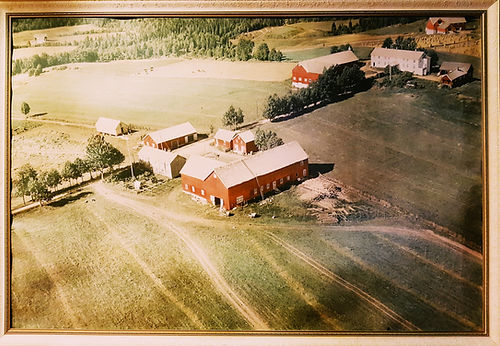Staven farm is a traditional agricultural property. The farm was probably cleared before the Viking Age.
The farm has been in the family since 1772. The current owner is the 8th generation owner. Previously, the farm was a monastery estate, and belonged to Bakke monastery in Trondheim.
Staven gård today consist of organic milk and meat production, forestry and tourism.
There are 4 old houses on the farm, which today are part of the tourism investment. They represent traces of a bygone era, and tell a lot about our culture and old days' work and toil.


A property/house mark, "bumerke", is a graphic figure.
The purpose of "bumerke" was to have a brand that a person, family or owner of a property could use to mark objects, cattle and buildings. The use of "bumerke" dates back to long before written language was common knowledge. "Bumerker" were used by farmers, traders, artisans and others.
There are also "bumerker" written by hand on documents, including from miners in Røros and on some farmers' proxies.
The picture shows "bumerker" from Namdalseid around the year 1700. It is taken from the Namdalseid book, Bygd, gard, ætt.
Here is a picture of two of the Staven farms. The photo was taken around 1950.
The name Staven is probably a "vin" name, the only one on Namdalseid. The word "vin" was used in the old days about grassland, natural meadow. The "vin" names are considered among the oldest names we have. The first syllable stave probably comes from Old Norse stafr . It is uncertain what significance it has in this context, but it has been suggested that it may be perceived as a mountain name.
The staff is in older sources called desolate farm, and was probably deserted after the Black Death. The spelling has been influenced by it: Stafføden, Staffuin, Stauin, Stafføune, Staføvnet.
From the picture it can be seen that the road goes through both courtyards, it was common and convenient. As the means of transport became larger and faster, the roads were rerouted outside the courtyards. In the Staven hamlet, the road was rerouted in the mid-70s.


Svartmosetra was used as summer pasture from the 1900s to the 1940s. And for a few years after, it was used as a forestry living room.
It was Beata Staven who built Svartmosetra. It consisted of manor house, stable and barn. The barn no longer exists, but the farmhouse and stable were restored in 2017.
For a couple of generations the Stabburet and Masstua have only been used as storage for old objects. Everything from tools and outdoor utensils to kitchen utensils.
We have made a small farm museum. The plan is to make a nice exhibition eventually. Ask us and you are welcome to visit our museum.



